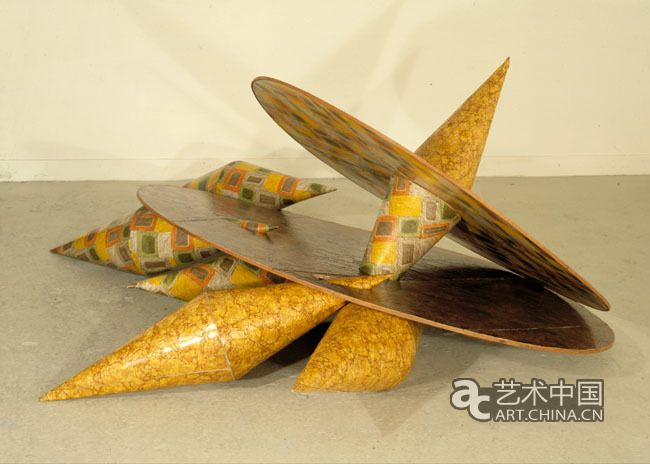理查德迪肯的《男孩和女孩》 |
| 藝術中國 | 時間: 2010-01-29 18:37:14 | 文章來源: 英國文化協會當代藝術珍藏展 展覽作品 |
|
理查德迪肯的《男孩和女孩》 Richard Deacon Boys and Girls(come out to play) 1982 Linoleum and plywood 91.5 x 183 x 152.2 cm 理查德.迪肯 男孩和女孩(出來玩) 1982 硝酸鋰和膠合板 91.5 x 183 x 152.2 cm
迪肯是一位英國皇家空軍飛行員的兒子,他的作品經常被比喻為機器部件或滑翔機、飛機庫的框架結構,或其他與航空相關的用具。在20世紀80年代早期,他開始創作雕塑,採用膠合板、鍍鋅鋼、波紋鐵、布料和油氈創造隆起的曲線形狀,這些材料都是簡單易得的普通材料,突破了傳統雕塑對於選材的狹隘觀點。他把自己描述為一個裝配工(“我關心的中心內容是材料和操作” ),他説自己並不雕刻或塑造材料,而是把材料組裝構造在一起。鋼質鉚釘、螺栓和粗糙的表面都包含在他作品的最終形態裏,強調了將材料組合構成形狀的感覺。雖然這些作品的材料來源要歸功於工業的進步發展,但是它們呈現出的結果卻具有驚人的原始自然感,其作品包含的典型形狀是旋轉扭曲的波狀形態,仿佛巨大的鉛筆屑條或DNA雙鏈。除了類似《男孩和女孩(出來玩耍)(Boys and Girls (come out to play))》這樣的家庭類作品之外,迪肯也承接了大量公共創作委託任務,其中很多靈感都來源於自然風景。他的大型雕塑《個人(Individual)》(2004) 的原型就來自於他從空中拍攝的蘇格蘭泰河的照片,這條河像絳蟲一樣扭曲穿過廣袤的鄉村。其他的作品則是從紙上的亂涂亂畫開始,似乎像蒸汽痕跡一樣漸漸伸展生長,藝術家努力保持它們流動變化的持續狀態,充分表現它們永不固定或完結的潛力。 作為一名多産的作家,迪肯將雕塑比喻為口頭語言,認為雕塑內部、外部和之間的空間與對話類似,也擁有自己的節奏、隱喻和韻律。“我認為製造事物、構建結構是一種和語言的力量很相近的活動,因為這也是一種塑造形狀的方法……當然這和語言的順序並不完全一樣,但是通過這種方法,我們能讓這個紛亂繁雜的世界為人所理解。” 他還利用比例獲得顛覆性的效果,經常用雙關語、諺語和兒歌為自己的作品命名,營造了雕塑和觀者之間驚人的親近感。迪肯經常提到西格蒙德•弗洛伊德的戲劇理論,即弗洛伊德在《超越快樂原則》(1920)中所説的:模倣性戲劇就是掌控我們周圍環境的一種方法。迪肯在比例、結構和製造方面的玩耍戲謔之性充分表現在《男孩和女孩(出來玩耍)》這樣的作品中,這件作品的靈感一部分來自於他女兒的出生。作品是用花紋油氈包裹著膠合板做成的,酷似一件黃色、橙色和棕色的耐用現代設計作品。整件雕塑表現了一組扔在走廊地上的破爛陀螺,顯然是因為孩子找到了更有趣的玩具而被遺棄。 J.L. Richard Deacon Son of an RAF career pilot, Deacon’s work has often been compared to machine parts or the skeletal frames of gliders, hangars, or other paraphernalia associated with aviation. In the early 1980s, he began making sculpture which employed swelling, curvilinear forms made from laminated wood, galvanised steel, corrugated iron, cloth and linoleum: materials which were serviceable, readily to hand and not burdened with the weight of sculptural tradition or preconceptions. He has described himself as a fabricator (‘material and manipulation are core ideas in what I do’ ), explaining that he neither carves nor models his materials, but constructs them. The steel rivets, bolts and rough surfaces become part of the final form, reinforcing a sense of the material being manipulated into shape. Despite their debt to industrial processes, the results are surprisingly organic-looking, with, typically, undulating forms that snake into themselves like giant pencil shavings or a DNA double helix. In addition to works of a domestic scale, such as Boys and Girls (come out to play), Deacon has also undertaken a large number of public commissions, many of them inspired by the landscape. The large sculpture Individual (2004) began with an aerial photograph he took of the River Tay in Scotland, twisting like a tapeworm through the countryside. Other works begin as doodles on paper and appear to grow like vapour trails, the artist attempting to keep them constantly in a state of transition and flux, full of potential that is never fixed or pinned down. A prolific writer, Deacon compares sculpture to the spoken word and considers the space in, around and between a sculpture similar to a conversation, with its rhythms, metaphors and cadences. ‘I think of making things, structuring, as being an activity not unlike the power of speech, in that it is a means of giving shape… its obviously not in the same order as language, but it’s a means whereby the world, a chaotic universe, is actually made understandable.’ He also plays a subversive game with scale, often titling his works using puns, proverbs and nursery rhymes, creating a surprising intimacy between the sculpture and the viewer. Deacon has spoken of Sigmund Freud’s theories of play, as outlined in Beyond the Pleasure Principle (1920), in which Freud claims that imitative play is a means of mastering the environment around us. Deacon’s playfulness in scale, structure and fabrication is brought out in full in a work such as Boys and Girls (come out to play), which was partly inspired by the birth of his daughter. It is made of plywood and wrapped in functional patterned lino, featuring a durable Modernist design in yellow, orange and brown. The sculpture resembles a group of discarded and broken spinning tops on the gallery floor, abandoned for more lively pleasures. J.L. |
| 注:凡註明 “藝術中國” 字樣的視頻、圖片或文字內容均屬於本網站專稿,如需轉載圖片請保留 “藝術中國” 浮水印,轉載文字內容請註明來源藝術中國,否則本網站將依據《資訊網路傳播權保護條例》維護網路智慧財産權。 |
